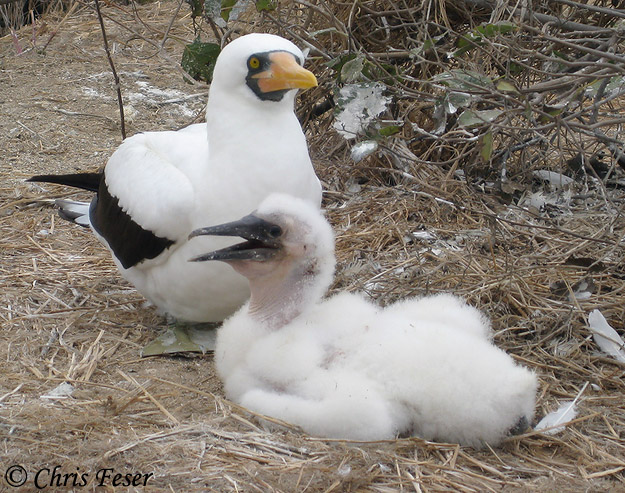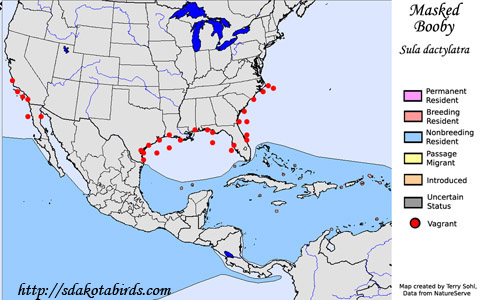| Length: 32 inches | Wingspan: 62 inches | Seasonality: Non-resident in South Dakota |
| ID Keys: Adults white overall with black wing coverts and tail. Juveniles dark above and white below. | ||
 The
Masked Booby is another Booby species with a wide geographic range, as they
are found throughout much of the tropical warm waters of the Pacific Ocean,
as well as in the western Atlantic Ocean. While they have always been
known to nest in many locations in the Caribbean, they were unknown as
breeding birds in the continental United States until nesting attempts began
on the Dry Tortugas in Florida in the 1980s. They also can be found
nesting in the Hawaiian Islands. A very similar species, the Nazca
Booby, was recently recognized as a separate species. The Nazca Booby
is found as a breeding bird off the northern coast of South America,
including the Galapagos Islands.
The
Masked Booby is another Booby species with a wide geographic range, as they
are found throughout much of the tropical warm waters of the Pacific Ocean,
as well as in the western Atlantic Ocean. While they have always been
known to nest in many locations in the Caribbean, they were unknown as
breeding birds in the continental United States until nesting attempts began
on the Dry Tortugas in Florida in the 1980s. They also can be found
nesting in the Hawaiian Islands. A very similar species, the Nazca
Booby, was recently recognized as a separate species. The Nazca Booby
is found as a breeding bird off the northern coast of South America,
including the Galapagos Islands.
Habitat: Nesting occurs on tropical islands, usually those with low topography and a lack of large trees and shrubs. Outside of the breeding season, they can be found anywhere from areas close to shore, to far out to sea.
Diet: Feeds mostly on fish, but will also feed on squid.
Behavior: Forages by plunge diving, or by swimming on the ocean's surface and reaching down to grab prey when spotted.
Nesting: The nest of a Masked Booby is a simple shallow scrape on the ground, sometimes surrounded by a rim of pebbles, sticks, or other small bits of debris. The female lays one or two eggs, and both parents help to incubate them. Upon hatching, both parents help to feed the young. The young are fed by parents until they are 4 or 5 months old.
Song: At breeding colonies, young and female birds have a harsh honking call. Males have a thin whistling call. Away from breeding colonies, Masked Boobies are usually silent.
Migration: There are no clear migration patterns for Masked Boobies, but individual birds do often disperse widely from breeding colonies after the breeding season.
Interactive eBird map: Click here to access an interactive eBird map of Masked Booby sightings
Similar Species: Northern Gannet, white phase of Red-footed Booby
Conservation Status: Populations of Masked Boobies may be in decline. However, breeding colonies are numerous and widely scattered, and populations overall are still strong. The IUCN lists the Masked Booby as a species of "Least Concern".
Further Information: 1) New Zealand Birds Online -Masked Booby
2) Audubon Guide - Masked Booby
3) Cornell's All About Birds - Masked Booby
Photo Information: Photo taken by Chris Feser - Licensed under Creative Commons Attribution Generic 2.0 License.
| Click below for a higher-resolution map |
 |
| South Dakota Status: Non-resident in South Dakota |
Additional Masked Booby Photos (coming soon!!)
